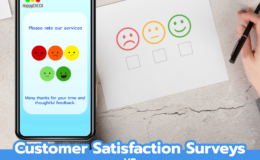Customer satisfaction Surveys are a crucial tool for companies looking to enhance the customer experience. These polls offer insightful input on the things that customers enjoy and dislike about the company, assisting businesses in making changes that can enhance customer loyalty and income. It can be difficult to design customer satisfaction questionnaires, though. In this post, we’ll look at some best practices and suggestions for developing customer satisfaction surveys that provide useful information.
1. Define Your Objectives
Defining your objectives is the first step in developing an efficient customer satisfaction survey. What do you hope to accomplish with the poll? Are you seeking ways to improve, gauge consumer loyalty, or get opinions on a brand-new good or service? Having clear objectives will make it easier for you to write focused, pertinent survey questions.
2. Keep It Short
Getting clients to really complete customer satisfaction surveys is one of the toughest issues. Keeping the survey brief and targeted is one strategy to boost response rates. Make sure each question is simple and easy to grasp, and limit the number of questions to no more than 10-15. An easy-to-complete survey that doesn’t need too much of the customer’s time will get more responses.
3. Use the Right Question Types
The kind of survey questions you choose can have a significant impact on the caliber of the feedback you get. Multiple-choice or rating questions are examples of closed-ended questions that are helpful for collecting quantitative data and may be simpler for customers to respond to. Open-ended inquiries, such as text boxes or comment sections, enable users to give more in-depth input and can yield insightful data about the user experience.
4. Avoid Leading Questions
Asking leading questions might skew the responses you get and produce false data. Asking questions that imply a specific response or are intended to elicit a specific reaction should be avoided. Avoid using terminology that can be construed as biased or leading and instead keep your queries impartial and objective.
5. Test Your Survey
Test your survey to make sure it is clear, simple to read, and error-free before distributing it to clients. Give the survey to a few coworkers or acquaintances, and ask them to comment on the questions and the overall experience. Prior to sending the customer survey, this will assist you in identifying any problems or potential areas for improvement.
6. Personalize Your Survey
Personalization may boost response rates and give clients a sense of value. For a more individualized experience, customize your survey by including client names or account information. Inquiries concerning a recent purchase or customer service experience, for instance, can be tailored based on the consumer’s previous experiences with the firm.
7. Offer Incentives
Offering incentives to your customers, like discounts or tickets into a drawing for prizes, might be a great way to get them to complete your survey. The incentives should not be very large, though, as this may result in skewed results. Maintain modest rewards that are pertinent to the client experience.
8. Provide Follow-Up
It’s crucial to follow up with your customers’ feedback once you’ve received it. Customers should be thanked for their input and informed of how it will be used to enhance the overall customer experience. Offer remedies or compensation if clients have voiced complaints to demonstrate that you value their input.
9. Analyze Your Results
It’s crucial to assess the feedback you’ve received from customers in order to spot trends and potential development areas. Quantitative data can be used to pinpoint the areas in which customers are most content or unsatisfied, and qualitative data can be used to comprehend the drivers of these responses. Utilize this data to enhance the client experience and develop a strategy for future surveys.
In conclusion, organizations that wish to enhance the customer experience must use customer satisfaction surveys as a key tool. By using these guidelines and recommendations, you can produce surveys that provide useful information and assist







